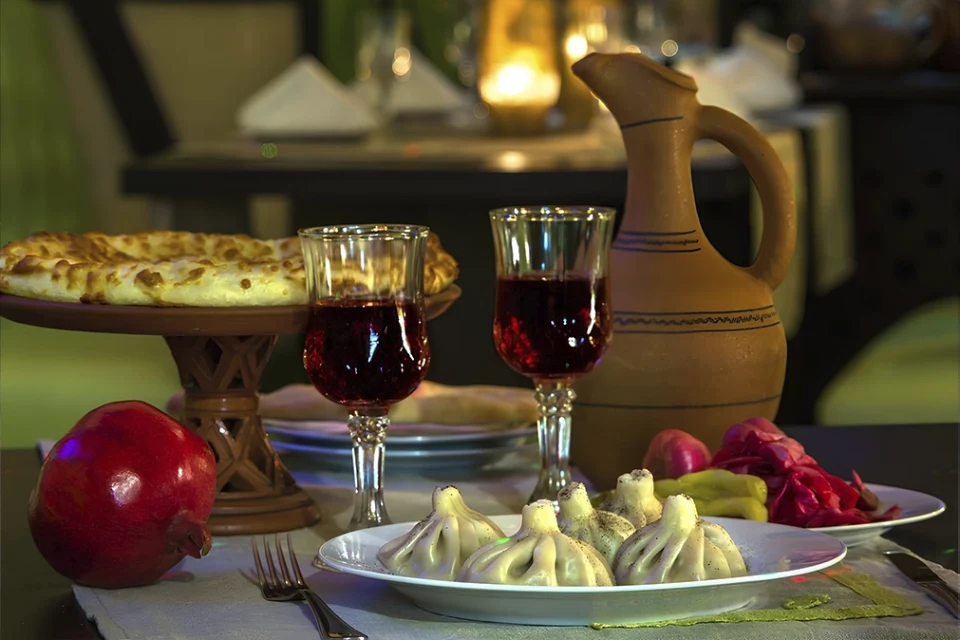


The History of Georgian Wine
Ancient Origins
- Georgia is often referred to as the “cradle of wine,” with a winemaking tradition that dates back over 8,000 years. Archaeological evidence, including ancient grape pips and winemaking artifacts, suggests that the cultivation of grapes and production of wine began in the region around 6000-5800 BCE.
- The ancient Georgians developed a unique winemaking method using large clay vessels called qvevri (also spelled kvevri). These vessels, which are buried underground, are used for fermenting, storing, and aging wine. The qvevri method is still in use today and is recognized by UNESCO as an Intangible Cultural Heritage of Humanity.
Cultural Significance
- Wine has been deeply woven into the social, religious, and economic fabric of Georgia. It has played a crucial role in Georgian rituals, celebrations, and daily life. In Georgian Orthodox Christian traditions, wine is a symbol of life and an essential part of religious ceremonies.
- The vine is also a national symbol in Georgia, representing prosperity and longevity. Many families have their own vineyards and produce wine for personal consumption, preserving traditional practices and local grape varieties.
Medieval to Modern Times
- Throughout history, Georgian winemaking has experienced various influences and challenges, including invasions, foreign rule, and political changes. Despite these challenges, the tradition of winemaking persisted, often blending local and introduced techniques and grape varieties.
- During the Soviet era, Georgian wine was highly regarded within the USSR, and the country became a major wine producer. However, the focus was often on mass production rather than quality.
Modern-Day Georgian Wine Culture
Revival and Global Recognition
- Since the collapse of the Soviet Union, there has been a revival and renaissance of Georgian wine. Winemakers have increasingly focused on quality, traditional methods, and unique local grape varieties. This revival has brought international recognition and appreciation for Georgian wine, especially those produced using the qvevri method.
- Georgian wines are now exported worldwide, and the country has gained a reputation as a producer of distinctive and high-quality natural wines. The qvevri wines, in particular, are celebrated for their unique characteristics, often described as earthy, complex, and rich in tannins.
Wine Tourism
- Georgia has become a popular destination for wine tourism, attracting visitors with its scenic vineyards, ancient winemaking traditions, and warm hospitality. Wine regions like Kakheti, Kartli, and Imereti offer wine tours, tastings, and cultural experiences. Many wineries combine traditional and modern techniques, offering a diverse range of wines to explore.
Diversity of Grape Varieties
Georgia is home to over 500 indigenous grape varieties, though only a small number are widely cultivated today. Some of the most famous include:
- Saperavi: A red grape variety known for producing deep, robust wines with high acidity and tannins.
- Rkatsiteli: A white grape variety often used in both qvevri and modern winemaking, producing wines with a crisp, fresh character.
- Mtsvane: Another white grape, known for its aromatic qualities and often blended with Rkatsiteli.
Contemporary Trends
- In recent years, there’s been a growing interest in natural and organic winemaking in Georgia, aligning with global trends. Many Georgian winemakers are committed to sustainable practices, minimal intervention, and the use of traditional methods.
Conclusion
- Georgian wine is not just a product but a cultural and historical treasure that embodies the spirit and resilience of the Georgian people. Its rich history, unique winemaking methods, and diverse flavors continue to captivate wine enthusiasts around the world, making it a key aspect of Georgia’s cultural heritage and contemporary identity.
Check out these great wine tours:
5 main reasons why Georgia is worth traveling to Georgia stands out from other countries with its unique nature, historical heritage, language and cultural diversity. It is a country that captivates visitors with its beautiful landscapes, ancient culture and warm-hearted people. Exceptional nature From the Caucasus Mountains to the Black Sea climate, Georgia offers stunning… Continue reading 5 main reasons why Georgia is worth traveling to
Georgian culture Georgian culture is rich and diverse, deeply rooted in the history and traditions of the Georgian people. Situated at the crossroads of Europe and Asia, Georgia has been influenced by various civilizations and empires, which is reflected in its cultural heritage. Georgian culture is an exotic, mysterious and ancient culture stretching back for… Continue reading Georgian Culture
The History of Georgian Wine Ancient Origins Georgia is often referred to as the “cradle of wine,” with a winemaking tradition that dates back over 8,000 years. Archaeological evidence, including ancient grape pips and winemaking artifacts, suggests that the cultivation of grapes and production of wine began in the region around 6000-5800 BCE. The… Continue reading Georgian Wine
When you think of Georgia, your mind may wander to breathtaking mountain landscapes, ancient churches, and warm hospitality. But to truly understand the soul of this beautiful country, you must experience its food. Georgian cuisine is a rich blend of bold flavors, fresh ingredients, and centuries-old traditions — a true feast for the senses. Georgian… Continue reading Georgian Cuisine
Georgia, nestled at the crossroads of Europe and Asia, offers a diverse array of resorts that cater to every traveler’s desires—from serene mountain retreats and rejuvenating spa towns to sun-kissed Black Sea beaches and historic wine regions. Here’s a curated guide to some of the country’s most captivating resort destinations. Everyone likes to vacay at… Continue reading Resorts of Georgia







